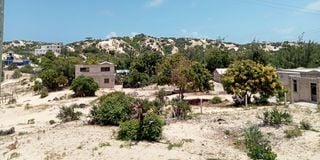Why Lamu's sand dunes are to locals what the Nile is to Egyptians

The Shella sand dunes in Lamu County. The Shella sand dunes are the only freshwater reservoirs serving more than 30,000 residents of the archipelago.
For residents of Lamu, the sand dunes in Shella area are to them what the Nile is to the Egyptians.
Their presence is made more conspicuous by white sand covered in parts by shrubs and trees.
The Shella sand dunes are the only freshwater reservoirs serving more than 30,000 residents of the archipelago.
In fact, Lamu’s sand dunes are considered its economic, social, environmental and cultural lifeline.
They run through to the southern end of the island in Kizingoni to Ras Singue. They stretch for 12 kilometres, covering an area of about 958 hectares and rise to a height of at least 60 metres above sea level, forming a continuous ridge along Lamu Bay that protects against the strong open sea winds.
Abdallah Alawy, a conservationist in Lamu, said apart from providing fresh water, the sand dunes also serve another crucial function – as natural barriers against wind and waves and hence protecting inland areas from storm damage.
“The dunes act as the sole catchment area where rain water percolates through the sand. Wells have been dug at the dunes to provide water for Lamu Island,” Mr Alawy said.
"Had these sand dunes been nonexistent, I believe Lamu Island, including the old town, wouldn’t be existing,” explained.
Yusuf Ahmed cites the 2006 tsunami as one of the occurrences that illustrated how important the sand dunes are to the archipelago.
“Many East African coastlines were substantially affected with the exception of Lamu harbour. The sand dunes protected Lamu Island from the strong open sea tsunami winds,” he said.
But despite serving such crucial functions, the sand dunes are threatened, especially by the many developments coming up on the island.
Mohamed Athman, the executive director of the Lamu Marine Forum and an environmental rights defender, is concerned that the sand dunes might be depleted because of careless development.
Some people, he noted, have encroached on the dunes or attempted to.
“We’ve already begun witnessing frequent water scarcity and shortages in Lamu. The developments undertaken within the Shella sand dunes have resulted in exhausted aquifers on the island,” he said.
“In recent times, water has increasingly become saline. Something needs to be done urgently to preserve and protect our sand dunes.”
Bunu Bakari, an elder in Shella, said fresh water supply and proper sanitation are the key cornerstones of the island's economic survival.
“We’re happy having these sand dunes. They are Lamu Island’s ‘water tower’. They’re God-given as they’re the only freshwater catchment area. Let’s respect these treasured sand dunes,” Mr Bakari said.
Since the 1960s, the National Museums of Kenya (NMK) has been actively involved in the development of Lamu Old Town as a cultural heritage site owing to its centuries-old urban landscape, its unique architecture and an unperturbed traditional way of life.
NMK Curator Mohammed Mwenje noted that two of the complimentary buffer zone areas that are part of the natural landscape and from which the town draws its water and beauty are the dunes.
Efforts are underway to ensure they are protected, considering they are the only membrane between seawater and fresh water for the archipelago, Mr Mwenje said.
If any development is allowed on the dunes, he warned, Lamu will not have fresh water in the coming years.
In March 2002, NMK gazetted about 958 hectares of the sand dunes in Shella as a protected site under the Antiquities and Monument Act (Cap215) because development on the dunes would threaten island life.
“And that’s why NMK had to come in and gazette both the Lamu-Shela Sand Dunes and the Ras Kitau-Manda skyline as complimentary areas to the buffer zone of the Lamu World Heritage site.
“One of the major reasons for Lamu’s 700 years of continuous habitation lies in its relatively vast resources of potable water, the most prominent of which is the Shella Sand Dune regime …,” he said.
The dunes, he added, act “as a giant sponge, capable of absorbing and retaining rainwater, and as a membrane preventing seawater from mixing with underground water aquifers”.





